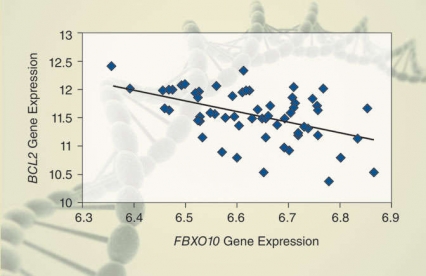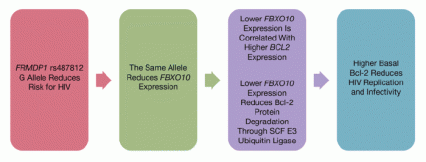
Researchers have identified a gene variant that appears to partially shield people whose behaviors entail high risk for exposure to human immunodeficiency virus (HIV) from becoming infected. The finding could point a way to medications that prevent HIV that has entered the body from establishing infection.
Dr. Eric O. Johnson at RTI International and colleagues found that participants in two large study cohorts who possessed the G allele of a single-nucleotide polymorphism in the FRMPD1 gene (rs4878712) had modestly lower odds of acquiring HIV infection than those with alternative alleles, after accounting for behavioral and environmental risk factors.
All participants in each cohort—the Urban Health Study (UHS; 3,136 males and females), and the Women’s Interagency HIV Study (WIHS; 2,533 females)—were considered to be at high risk for HIV infection related to their sexual, sexually transmitted disease, or drug-use histories. Using genome-wide association analysis, the researchers first established the gene-infection association with data from the UHS cohort and then replicated their finding in the WIHS cohort.
 Figure 1. Expression of the HIV-Protective BCL2 Gene Is Negatively Correlated With Expression of the FBXO10 Gene Lower levels of FBXO10 expression correspond to higher expression of BCL2.
Figure 1. Expression of the HIV-Protective BCL2 Gene Is Negatively Correlated With Expression of the FBXO10 Gene Lower levels of FBXO10 expression correspond to higher expression of BCL2.
- Text Description of Figure 1
-
The figure shows a scatter plot of the relationship of the expression of two genes, BCL2 and FBXO10. As shown by a regression line fitted to more than 20 data points of BCL2 versus FBXO10 expression, higher BCL2 expression (i.e., an expression level of about 12.1 on the vertical y-axis) on the left side of the graph is associated with lower FBXO10 expression (expression level of about 6.35 on the horizontal x-axis). Conversely, lower BCL2 expression (expression level of about 11.10) on the right of the graph is associated with higher FBXO10 expression (expression level of about 6.87). The gradual, left-to-right decrease in the regression line indicates an inverse relationship of BCL2 and FBXO10 gene expression.
Dr. Johnson and colleagues suggest that the pathway linking the FRMPD1 gene variant to reduced risk for HIV infection involves altered expression of two genes, FBOX10 and BCL2. The researchers found that the G allele of rs4878712 was associated with lower expression of the gene FBOX10, and that lower FBOX10 expression was associated with higher BCL2 expression (Figure 1). Greater expression of the BCL2 gene leads to higher levels of Bcl-2 protein, which other studies have shown to lower HIV replication during acute infection, and thereby reduce the likelihood of transition to persistent infection (Figure 2).
Although previous studies have estimated that half of a person’s risk for acquiring HIV infection depends on his or her genes, rs4878712 is only the second gene variant that researchers have associated with risk for infection. The finding is most significant for the insight it may provide into biological mechanisms that can facilitate or impede persistent HIV infection and could become targets for medications.
 Figure 2. The Proposed Relationship of the FRMPD1 SNP rs4878712 With a Reduced Risk for HIV Infection Mediated by FBXO10 and the Bcl-2 Protein The observed reduced risk for infection with HIV of carriers of the G allele of the rs4878712 SNP is associated with reduced expression of the FBXO10 gene. The lower expression of FBXO10 is associated with higher expression of the BCL2 gene and reduced degradation of the Bcl-2 protein. The resulting higher basal levels of Bcl-2 decrease HIV levels and infectivity.
Figure 2. The Proposed Relationship of the FRMPD1 SNP rs4878712 With a Reduced Risk for HIV Infection Mediated by FBXO10 and the Bcl-2 Protein The observed reduced risk for infection with HIV of carriers of the G allele of the rs4878712 SNP is associated with reduced expression of the FBXO10 gene. The lower expression of FBXO10 is associated with higher expression of the BCL2 gene and reduced degradation of the Bcl-2 protein. The resulting higher basal levels of Bcl-2 decrease HIV levels and infectivity.
- Text Description of Figure 2
-
The figure shows a horizontal flow chart that summarizes the proposed effect of the FRMPD1 SNP rs4878712 on reduced risk for HIV infection. The left-most panel reads, "FRMPD1 SNP rs4878712 G allele reduces risk for HIV"; the next panel reads, "The same allele reduces FBXO10 gene expression”; the next panel reads, “Lower FBXO10 expression is correlated with higher BCL2 gene expression. Lower FBXO10 expression reduces Bcl-2 protein degradation through SCF E3 ubiquitin ligase"; and the last panel reads, "Higher basal Bcl-2 protein reduces HIV replication and infectivity."
This study was supported by NIH grants DA026141, DA097770, AI035004, and AI034989.
Source:
Johnson, E.O.; Hancock, D.B.; Gaddis, N.C., et al. Novel genetic locus implicated for HIV-1 acquisition with putative regulatory links to HIV replication and infectivity: A genome-wide association study. PLoS One 10(3), 2015. Full text and Correction
